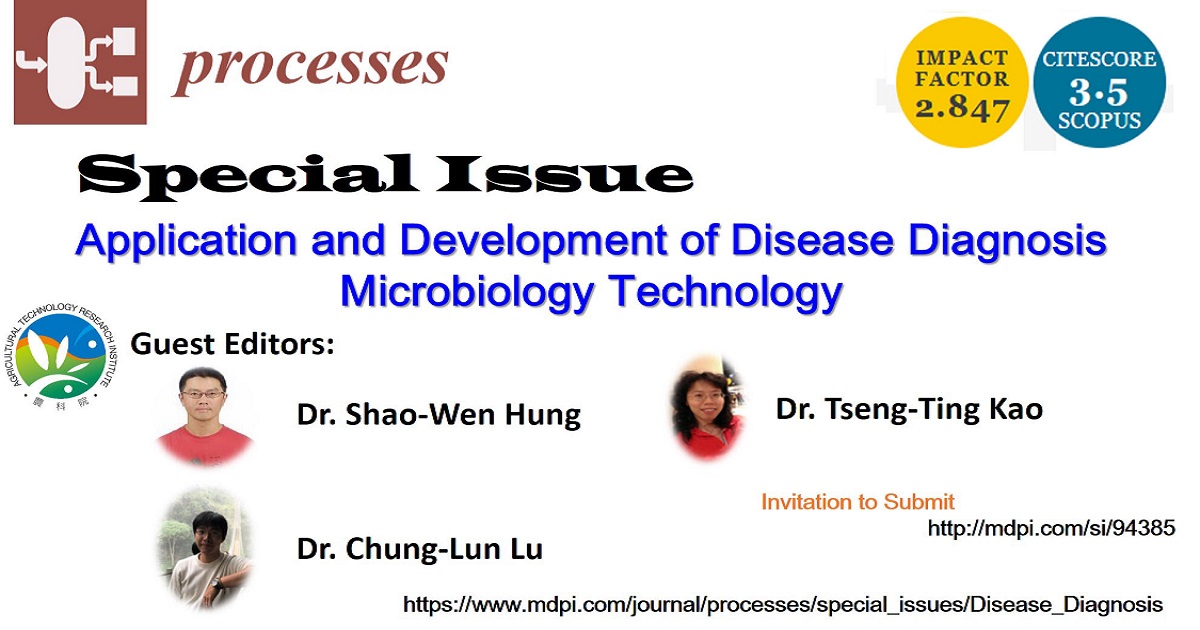Application and Development of Disease Diagnosis Microbiology Technology
A special issue of Processes (ISSN 2227-9717). This special issue belongs to the section "Biological Processes and Systems".
Deadline for manuscript submissions: closed (31 August 2022) | Viewed by 22805

Special Issue Editors
Interests: fish and shellfish immunology; oncology and cancer medicine; veterinary medicine and immunology; fish diseases and therapy; flow cytometry; experimental animal; animal welfare; epilepsy
Special Issues, Collections and Topics in MDPI journals
Interests: fish diseases and therapy; beneficial feed additives; aquaculture; acute and chronic toxicity tests of aquatic animals
Special Issues, Collections and Topics in MDPI journals
Interests: aging; disease animal model; dermatology and dermatitis; arthritis; folate metabolism; oxidative stress; inflammation; intestinal microbiota; alternatives to animal testing
Special Issues, Collections and Topics in MDPI journals
Special Issue Information
Dear Colleagues,
Technological microbiology is an important issue today. This technological microbiology was incorporated with biotechnological techniques that allowed the rapid identification of new molecules and microorganisms or even the genetic improvement of known microorganisms. Commonly, the participation of microorganisms in the generation of medical products or services involves four distinct aspects, i.e., disease control, vaccine production, antibiotic production, and biotherapeutic production. In this Special Issue, the application and development of disease diagnosis microbiology technology will be discussed in the disease control field in detail.
Dr. Shao-Wen Hung
Dr. Chung-Lun Lu
Dr. Tseng-Ting Kao
Guest Editors
Manuscript Submission Information
Manuscripts should be submitted online at www.mdpi.com by registering and logging in to this website. Once you are registered, click here to go to the submission form. Manuscripts can be submitted until the deadline. All papers will be peer-reviewed. Accepted papers will be published continuously in the journal (as soon as accepted) and will be listed together on the special issue website. Research articles, review articles as well as short communications are invited. For planned papers, a title and short abstract (about 100 words) can be sent to the Editorial Office for announcement on this website.
Submitted manuscripts should not have been published previously, nor be under consideration for publication elsewhere (except conference proceedings papers). All manuscripts are thoroughly refereed through a single-blind peer-review process. A guide for authors and other relevant information for submission of manuscripts is available on the Instructions for Authors page. Processes is an international peer-reviewed open access monthly journal published by MDPI.
Please visit the Instructions for Authors page before submitting a manuscript. The Article Processing Charge (APC) for publication in this open access journal is 2000 CHF (Swiss Francs). Submitted papers should be well formatted and use good English. Authors may use MDPI's English editing service prior to publication or during author revisions.
Keywords
- application
- development
- disease diagnosis
- microbiology technology
- microorganism
Benefits of Publishing in a Special Issue
- Ease of navigation: Grouping papers by topic helps scholars navigate broad scope journals more efficiently.
- Greater discoverability: Special Issues support the reach and impact of scientific research. Articles in Special Issues are more discoverable and cited more frequently.
- Expansion of research network: Special Issues facilitate connections among authors, fostering scientific collaborations.
- External promotion: Articles in Special Issues are often promoted through the journal's social media, increasing their visibility.
- e-Book format: Special Issues with more than 10 articles can be published as dedicated e-books, ensuring wide and rapid dissemination.
Further information on MDPI's Special Issue polices can be found here.







